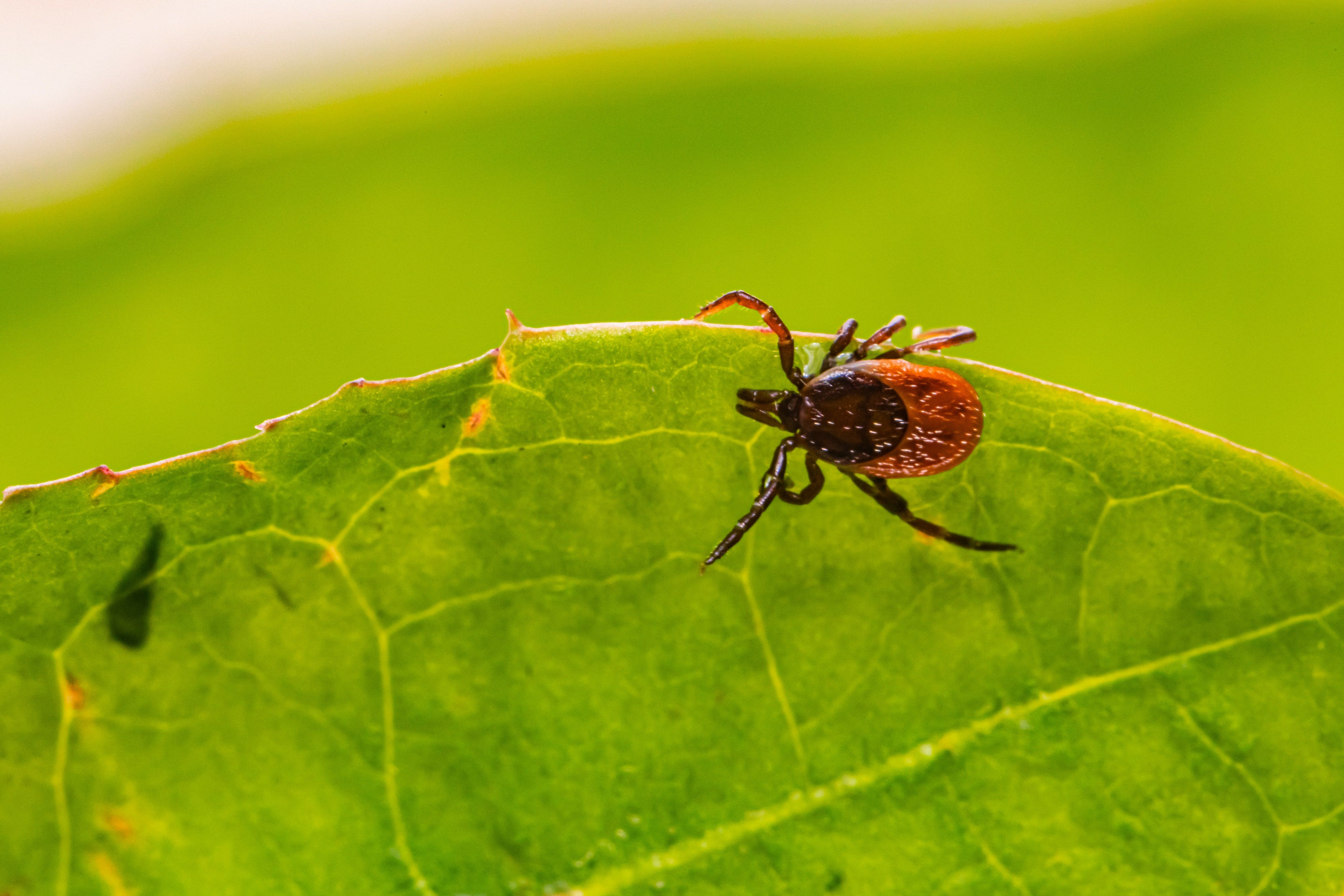Pets are naturally curious, which sometimes leads them into unexpected run-ins with insects or other critters. Whether it’s a tick bite after a romp through the woods or a bee sting during backyard play, knowing what to do in the moment can make all the difference in keeping your pet safe and comfortable.
Here’s your go-to guide for managing common bites and stings—plus when it’s time to call your veterinarian.
Tick Bites
What Are Ticks?
Ticks are external parasites that feed on the blood of mammals, birds, and reptiles. Their specialized mouthparts allow them to latch onto a host and remain attached for several days. While they’re most active in warm months, they can be found year-round in many areas.
Ticks typically need to be attached for at least 24 hours to transmit disease, though the exact timing depends on the type of tick and pathogen. The longer the tick is attached, the greater the risk of transmission.
What to Do:
- Remove the tick promptly: Use fine-tipped tweezers to grasp the tick as close to your pet’s skin as possible. Pull upward with steady, even pressure. If the tick’s head detaches, don’t panic, as the body is no longer infectious. Try to remove the remaining head with tweezers, but don’t force it. If it stays embedded, consult your vet and monitor for signs of inflammation or infection including redness, swelling, pain, and pus.
- Clean the area: Use antiseptic or soap and water to clean the bite site.
- Watch for symptoms: Monitor for infection at the bite site and general signs of illness such as fever, lethargy, or pain. Tick-borne illnesses like Lyme disease may not appear immediately, so if your pet was bitten, especially for a long period, call your vet.
Why It Matters: Ticks can transmit serious diseases, and symptoms aren’t always obvious right away. Tick bites can lead to infections, fever, joint pain, or more severe health problems. Early removal and close monitoring are key to protecting your pet’s health.
Bee or Wasp Stings
Bee and wasp stings tend to occur during the warmer months, especially spring through early fall. Dogs are usually stung on the face or paws, and in most cases, symptoms are mild and include minor pain, irritation, or swelling. But some situations, like stings in the mouth or multiple stings, can be serious or even life-threatening. These are all emergencies that require urgent veterinary treatment.
Symptoms of a Sting:
- Whining, agitation, or restlessness
- Swelling or lumpiness
- Biting, licking, or pawing at the area
- Drooling
What to Do:
- Remove the stinger (if present): Unlike wasps, bees typically leave their stinger behind, which can continue to inject venom into the skin. If you find a stinger still embedded, gently scrape it out using a flat, thin object like a credit card or a fingernail, just below the venom sac. Avoid using tweezers or your fingers to pinch it out, as this can squeeze more venom into your dog, increasing pain and swelling.
- Apply a cold compress: Wrap an ice pack in a cloth and hold it to the area for 10–15 minutes to reduce pain and swelling.
- Monitor for allergic reactions: Signs like swelling beyond the sting site, vomiting, difficulty breathing, or hives require immediate veterinary care.
Can I Give My Dog an Antihistamine?
Some human antihistamines are safe for dogs, but always consult your veterinarian first. They’ll advise on whether your pet needs to be seen and can recommend the safest medication and dosage.
When Is It an Emergency?
Stings inside the mouth or throat can cause life-threatening swelling that obstructs the airway. Allergic reactions may happen immediately (within 10 minutes), but can also be delayed by a few hours, or rarely, a day or more.
Signs of a Serious Allergic Reaction Include:
- Vomiting or diarrhea
- Severe or widespread swelling
- Swelling of the mouth or neck
- Collapse or disorientation
- Breathing difficulty or wheezing
Anaphylaxis is a medical emergency. Anaphylaxis is a severe and potentially life-threatening allergic reaction that can occur within minutes of exposure to an allergen. It involves multiple body systems and often presents with symptoms affecting the skin, respiratory tract, cardiovascular system, and gastrointestinal tract. Immediate veterinary care can be lifesaving.
Ant Bites
Depending on the species, ants can bite, sting, or both, and the effects range from mildly irritating to potentially life-threatening. Fire ants, in particular, are a serious concern. These aggressive, venomous insects were originally found in the South and Southwest but have since spread to other regions of the country. Fire ants bite to anchor themselves and then sting repeatedly, injecting venom that causes intense pain, swelling, and in some cases, anaphylaxis. Because they often attack in large groups with coordinated stings, fire ant encounters can be especially dangerous, and even deadly, for pets.
Bites most commonly occur on the paws, legs, nose, or belly.
What to Do:
- Clean the area: Gently wash with soap and water.
- Apply a cold compress: Helps reduce swelling.
- Soothe irritation: Ask your vet whether antihistamines or topical hydrocortisone are appropriate for your pet.
- Watch for signs of allergic reaction: If your pet vomits, has trouble breathing, or becomes weak, seek emergency care right away.
Why It Matters: Fire ant stings can escalate quickly. Prompt action helps prevent serious complications, including infection and anaphylaxis.
Spider Bites
Most spider bites are harmless, but a few, like bites from black widows or brown recluses, can cause serious health issues.
Symptoms May Include:
- A small, raised bump
- Redness and swelling
- Pain or tenderness
- Lethargy or muscle tremors (in more severe cases)
- Licking or pawing at the site
When to Seek Veterinary Help: If you notice muscle tremors, difficulty breathing, head tremors, or if the site becomes an open wound, bring your pet in right away. Treatment may include pain control, wound care, or antibiotics.
Snake Bites
Types of Venomous Snakes:
- Rattlesnakes – Found throughout the Americas and are known for their distinctive rattle. Their venom is highly toxic.
- Copperheads – Less aggressive but still dangerous.
- Cottonmouths (Water Moccasins) – Common near Southeastern US waterways and very venomous.
Signs of a Snake Bite:
- Sudden swelling and pain
- Bruising or bleeding
- Weakness, collapse, or paralysis
- Drooling, vomiting, or tremors
- Rapid breathing or labored breathing
What to Do:
- Keep your pet still: Minimize movement to slow the spread of venom.
- Get to a vet immediately: Do not try to treat the bite yourself. Snake bites can be fatal without professional care. Call your vet or an emergency animal poison control service right away.
- Take note of the snake (safely): If you can, observe from a distance to help with identification, and do not try to capture or kill it. Keep your pet confined until you can get to a vet.
Why It Matters: Snake venom can lead to tissue damage, shock, and even death. Fast veterinary intervention with antivenom is often the difference between life and death.
Final Tips for Pet Parents
Whether it’s a minor sting or a more serious bite, being prepared can make a big difference. Here are a few final tips to help you stay ready and keep your pet safe when the unexpected happens:
- Prevent when possible: After outdoor time, check your pet for ticks and other pests. Keep your yard tidy, and ask your vet about preventive medications.
- Know when to call the vet: If your pet shows signs of serious pain, swelling, trouble breathing, or if you’re just unsure, don’t wait. Call a veterinarian immediately.
- Keep emergency contacts handy: Save the number for your local urgent/emergency vet in your phone as you never know when you’ll need it. If you’re in the Johns Creek and Alpharetta, Georgia area, keep Ruby Veterinary Urgent Care’s contact info handy. We’ll be standing by to help in an emergency.













